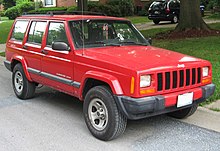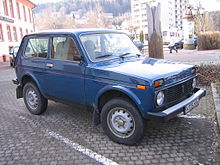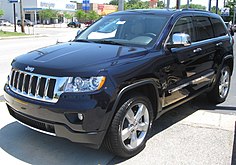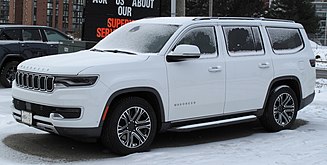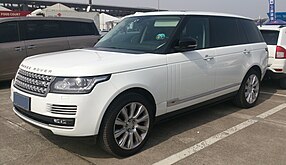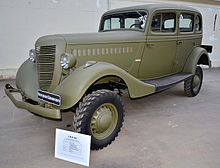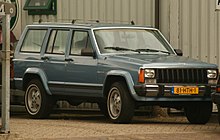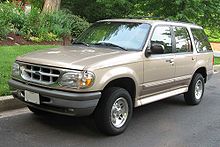SUV
This article has multiple issues. Please help improve it or discuss these issues on the talk page. (Learn how and when to remove these messages)
|
A sport utility vehicle (SUV) is a car classification that combines elements of road-going passenger cars with features from off-road vehicles, such as raised ground clearance and four-wheel drive.
There is no commonly agreed-upon definition of an SUV, and usage of the term varies between countries. Thus, it is "a loose term that traditionally covers a broad range of vehicles with four-wheel drive."[1] Some definitions claim that an SUV must be built on a light truck chassis; however, broader definitions consider any vehicle with off-road design features to be an SUV. A crossover SUV is often defined as an SUV built with a unibody construction (as with passenger cars); however, the designations are increasingly blurred because of the capabilities of the vehicles, the labelling by marketers, and the electrification of new models.[2]
The predecessors to SUVs date back to military and low-volume models from the late 1930s, and the four-wheel-drive station wagons and carryalls that began to be introduced in 1949. Some SUVs produced today use unibody construction; however, in the past, more SUVs used body-on-frame construction. During the late 1990s and early 2000s, the popularity of SUVs significantly increased, often at the expense of the popularity of large sedans and station wagons. SUVs accounted for 45.9% of the world's passenger car market in 2021.[3]
SUVs have been criticized for a variety of environmental and safety-related reasons. They generally have poorer fuel efficiency and require more resources to manufacture than smaller vehicles, contributing more to climate change and environmental degradation.[4] Between 2010 and 2018, SUVs were the second-largest contributor to the global increase in carbon emissions worldwide.[5] Their higher center of gravity increases their risk of rollovers. Their higher front-end profile makes them at least twice as likely to kill pedestrians they hit.[6][7][8] Additionally, the psychological sense of security they provide influences drivers to drive less cautiously.[9]
Definitions
[edit]There is no universally accepted definition of the sport utility vehicle.[10] Dictionaries, automotive experts, and journalists use varying wordings and defining characteristics, in addition to regional variations of usage by both the media and the general public. The auto industry also has not settled on one definition of the SUV.[10]
American English
[edit]Automotive websites' descriptions of SUVs range from specifically "combining car-like appointments and wagon practicality with steadfast off-road capability" with "chair-height seats and picture-window visibility"[11] to the more general "nearly anything with available all-wheel drive and raised ground clearance".[12] It is also suggested that the term "SUV" has replaced "jeep" as a general term for off-road vehicles.[13]
American dictionary definitions for SUVs include:
- "rugged automotive vehicle similar to a station wagon but built on a light-truck chassis"[14]
- "automobile similar to a station wagon but built on a light truck frame"[15]
- "large vehicle that is designed to be used on rough surfaces but that is often used on city roads or highways"[14]
- "passenger vehicle similar to a station wagon but with the chassis of a small truck and, usually, four-wheel drive"[16]
British English
[edit]In British English, the terms "4x4" (pronounced "four-by-four"), "jeep", four wheel drive, or "off-road vehicle" are generally used instead of "sport utility vehicle". The sardonic term "Chelsea tractor" is also commonly used, due to the perceived popularity of the vehicles with urban residents of Chelsea, London, and their likeness to vehicles used by farmers.[17] However, in the 2020s, the term SUV has entered usage in the United Kingdom[18][19][20][21]
The Collins English Dictionary defines a sport utility vehicle as a "powerful vehicle with four-wheel drive that can be driven over rough ground. The abbreviation SUV is often used."[22]
Other countries
[edit]In Europe, the term SUV is generally used for road-oriented vehicles, described as "J-segment" by the European Commission.[23][24][25] "Four-by-four" or the brand name of the vehicle is typically used for off-road-oriented vehicles. Similarly, in New Zealand, vehicles designed for off-road use are typically referred to as "four-wheel drives" instead of SUVs.
Government regulations
[edit]In the United States, many government regulations simply have categories for "off-highway vehicles" which are loosely defined and often result in SUVs (along with pick-up trucks and minivans) being classified as light trucks.[10][26] For example, corporate average fuel economy (CAFE) regulations previously included "permit greater cargo-carrying capacity than passenger carrying volume" in the definition for trucks, resulting in cars with removable rear seats, like the PT Cruiser, being classified as light trucks.[27]
This classification as trucks allowed SUVs to be regulated less strictly than passenger cars under the Energy Policy and Conservation Act for fuel economy, and the Clean Air Act for emissions.[28] However, from 2004 onwards, the United States Environmental Protection Agency (EPA) began to hold sport utility vehicles to the same tailpipe emissions standards as cars for criteria pollutants, though not greenhouse gas emissions standards as they were not set until 2010.[29][30] In 2011, the CAFE regulations were changed to classify small, two-wheel-drive SUVs as passenger cars.[31]
However, the licensing and traffic enforcement regulations in the United States vary from state to state, and an SUV may be classified as a car in some states but as a truck in others.[32] For industry production statistics, SUVs are counted in the light truck product segment.[33]
In India, all SUVs are classified in the "Utility Vehicle" category per the Society of Indian Automobile Manufacturers (SIAM) definitions and carry a 27% excise tax.[34] Those that are 4 metres (13 feet) long, have a 1,500 cc (92 cu in) engine or larger, along with 170 mm (6.7 in) of ground clearance, are subject to a 30% excise duty.[35]
In Australia, SUV sales were helped by having lower import duties than passenger cars. Up until January 2010, SUVs were subject to a 5% import tariff, compared with 10% for passenger cars.[36][37]
Higher parking fee
[edit]In February 2024, voters in Paris mandated a triple parking charge rate for SUVs, citing environmental impact and street capacity; this followed similar decisions in Lyon and Tübingen with similar ordinances being considered by London, Brussels and Amsterdam.[38]
Characteristics
[edit]Chassis
[edit]Many years after most passenger cars had transitioned to unibody construction, most SUVs continued to use a separate body-on-frame method, due to being based on the chassis from a light truck, commercial vehicle, pickup truck, or off-road vehicle.
The first mass-produced unibody four-wheel-drive passenger car was the Russian 1955 GAZ-M20 Pobeda M-72,[39][40] which could be considered the first crossover car. The 1977 Lada Niva was the first off-road vehicle to use both a unibody construction and a coil-sprung independent front suspension. The relatively compact Niva is considered a predecessor to the crossover SUV and combines a hatchback-like passenger car body with full-time four-wheel drive, low-range gearing, and lockable center differential.
Nonetheless, unibody SUVs remained rare until the 1984 Jeep Cherokee (XJ) was introduced and became a sales success. The introduction of the 1993 Jeep Grand Cherokee resulted in all Jeep SUV models using unibody construction,[41] with many other brands following suit since the mid-1990s. Today, most SUVs in production use a unibody construction and relatively few models continue to use body-on-frame construction.
Body style
[edit]SUVs are typically of a two-box design similar to a station wagon. The engine compartment is in the front, followed by a combined passenger/cargo area (unlike a sedan, which has a separate trunk/boot compartment).
Up until approximately 2010, many SUV models were available in two-door body styles.[42] Since then, manufacturers began to discontinue the two-door models as the four-door models became more popular.[43][44][45]
A few two-door SUVs remain available, such as the body-on-frame Suzuki Jimny, Mahindra Thar, Toyota Land Cruiser Prado, Ford Bronco,[46] and Jeep Wrangler[47][48] as well as the Range Rover Evoque crossover SUV.
Safety
[edit]
SUVs typically have high ground clearance and a tall body. This results in a high center of mass, which made SUVs more prone to roll-over accidents.[49][50] In 2003, SUVs were quoted as 2.5 times more likely to roll over in a crash than regular cars and that SUV roofs were more likely to cave in on passengers than in other cars, resulting in increased harm to passengers.[49][51]
Between 1991 and 2001, the United States saw a 150% increase in sport-utility vehicle rollover deaths. In 2001, though roll-overs constituted just 3% of vehicle crashes overall, they caused over 30% of occupant fatalities in crashes;[49] and in crashes where the vehicle did roll over, SUV occupants in the early 2000s were nearly three times as likely to be killed as other car passengers.[49] Vehicles with a high center of gravity do sometimes fail the moose test of maneuverability conducted by Swedish consumer magazine Teknikens Värld, for example, the 1997 Mercedes-Benz A-Class and 2011 Jeep Grand Cherokee.[52]
The increasing popularity of SUVs in the 1990s and early 2000s was partly due to buyers perceiving that SUVs provide greater safety for occupants, due to their larger size and raised ride height.[49][53][54][55] Regarding the safety of other road users, SUVs are exempted from U.S. regulation stating that a passenger car bumper must protect the area between 16 and 20 inches (41 and 51 cm) above the ground. This often increases the damage to the other car in a collision with an SUV, because the impact occurs at a higher location on the other car.[56][57] In 2000–2001, 60% of fatal side-impact collisions were where the other vehicle was an SUV, an increase from 30% in 1980–1981.[58]
The introduction of electronic stability control (ESC) and rollover mitigation, as well as increased analysis of the risks of a rollover, led the IIHS to report in 2015 that "the rollover death rate of 5 per million registered vehicle years for 2011 models is less than a quarter of what it was for 2004 models. With ESC dramatically reducing rollover risk, the inherent advantages offered by SUVs' greater size, weight, and height emerge more clearly. Today's SUVs have the lowest driver death rate of any vehicle type."[59]
The high danger for cyclists and pedestrians of being seriously injured or even killed by SUV drivers has caused some public protests against SUVs in urban areas.[60] In 2020, a study by the U.S.-based IIHS found that, of a sample of 79 crashes from three urban areas in Michigan, SUVs caused more serious injuries compared to cars when impacts occurred at greater than 31 km/h (19 mph). The IIHS noted the sample size of the study was small and that more research is needed.[61] The popularity of SUVs contributed to an increase in pedestrian fatalities in the U.S. during the 2010s, alongside other factors such as distracted and drunk driving.[62]
A 2021 study by the University of Illinois Springfield showed that SUVs are 8 times more likely to kill children in a collision than passenger cars, and multiple times more lethal to adult pedestrians and cyclists.[63]
Environmental impact
[edit]SUVs generally have poorer fuel efficiency than smaller cars,[64] and thus contribute more to environmental degradation and global warming.
SUVs emit about 700 megatonnes of carbon dioxide per year,[4] a gas that is linked to global warming. According to the International Energy Agency, from 2010 SUVs have been the second-largest contributor to the increase in global CO2 emissions, second only to the power sector.[4]
SUVs were responsible for all of the 3.3 million barrels a day growth in oil demand from passenger cars between 2010 and 2018, whereas efficiency improvements in smaller cars saved over 2 million barrels a day, with electric cars reducing oil demand by under 100,000 barrels a day.[4]
Whereas SUVs can be electrified,[65] or converted to run on a variety of alternative fuels, including hydrogen,[66] their (manufacturing) emissions will always be larger than smaller electric cars.[67] On average, SUVs consume about a quarter more energy than medium-size cars.[4] Furthermore, the vast majority of these vehicles are not converted to use alternative fuels.
Between 2010 and 2018 SUVs were the second largest contributor to the global increase in carbon emissions worldwide.[5]
Types of SUV
[edit]Crossover SUV
[edit]The "crossover SUV" segment (also known as "CUVs" or simply "crossovers") has become increasingly popular since around 2010. Crossovers are often based on a platform shared with a passenger car, as a result, they typically have better comfort and fuel economy, but less off-road capability (many crossovers are sold without all-wheel drive) than pickup truck-based SUVs.[68][69][70]
The difference between crossovers and other SUVs is sometimes defined as a crossover being built using a unibody platform (the type used by most passenger cars), while an SUV is built using a body-on-frame platform (the type used by off-road vehicles and light trucks).[71][72][73] However, these definitions are often blurred in practice, since unibody vehicles are also often referred to as SUVs.[74][75] Also, crossover is a relatively recent term and early unibody SUVs (such as the 1984 Jeep Cherokee) are rarely called crossovers. Due to these inconsistencies, the term SUV is often used as a catch-all for both crossovers and SUVs.[76]
Outside of the United States, the term crossover tends to be used for C-segment (compact) or smaller vehicles, with large unibody vehicles—such as the Mercedes-Benz GLS-Class, BMW X7, and Range Rover—usually referred to as SUVs rather than crossovers. In the United Kingdom, a crossover is sometimes defined as a hatchback model with raised ride height and SUV-like styling features.[77][78]
- Examples: Category:Crossover sport utility vehicles ( 412 )
Mini SUV
[edit]The smallest size class of SUVs is the "mini SUV". In Japan, SUVs under 3,400 mm (133.9 in)—such as the Mitsubishi Pajero Mini—are included in the kei car category and therefore attract lower taxes.
Many recent vehicles labeled as mini SUVs are technically subcompact crossovers and are built on the platform of a subcompact (also called supermini or B-segment) passenger car.
- Examples: Category:Mini sport utility vehicles ( 109 )
-
Mitsubishi Pajero Pinin, mini SUV
-
Suzuki Jimny, off-road mini SUV
Compact SUV
[edit]The "compact SUV" is the next bigger-size class after mini SUVs.
Many recent vehicles labeled as compact SUVs are technically compact crossovers and are built on the platform of a compact (C-segment) passenger car.
- Examples: Category:Compact sport utility vehicles ( 239 )
-
Nissan Xterra, compact truck-based SUV
-
Jeep Cherokee, unibody SUV
Mid-size SUV
[edit]The next larger size is called the "mid-size SUV". Some mid-size SUVs are based on platforms shared with passenger cars and therefore, are crossovers. Other mid-size SUVs are based on compact or mid-size pickups.
- Examples: Category:Mid-size sport utility vehicles ( 229 )
-
Toyota Fortuner (also called SW4), mid-size truck-based SUV
-
Ford Bronco, off-road mid-size SUV with a compact two-door version available
-
Jeep Grand Cherokee, unibody mid-size SUV
Full-size SUV
[edit]Full-size SUVs are the largest size of commonly produced SUVs. Some, such as the Ford Expedition, and Chevrolet Tahoe, are marketed for their off-road capabilities, and others, such as the Lincoln Navigator and Cadillac Escalade, are marketed as luxury vehicles. While a few full-size SUVs are built on dedicated platforms; most share their platforms with full-size pickup trucks.
- Examples: Category:Full-size sport utility vehicles ( 75 )
-
Jeep Wagoneer, full-size SUV on a pickup truck-based platform
-
Cadillac Escalade, full-size luxury SUV
-
Mercedes-Benz GLS-class, full-size unibody SUV
Extended-length SUV
[edit]Some North American SUVs are available as a long-bodied version of a full-size SUV, which is called an "extended-length SUV" like the Ford Expedition EL and the Chevrolet Suburban. The additional length is used to provide extra space for rear passengers or cargo. As per the full-size SUVs they are based on, most extended-length SUVs are built on dedicated platforms, full-sized pickups (1⁄2 ton), or heavy-duty pickups (3⁄4 ton or more).
Extended-length SUVs are mostly sold in North America but may also be exported to other markets in small numbers.
-
GMC Yukon XL, extended-length SUV
-
Ford Excursion, extended-length SUV based on a heavy-duty truck platform
-
Range Rover L, extended-length unibody SUV
- Examples: Category:Expanded length sport utility vehicles ( 16 )
Coupe SUV
[edit]Some SUVs or crossovers with sloping rear rooflines are marketed as "coupe crossover SUVs" or "coupe SUVs", even though they have four side doors for passenger access to the seats and rear hatches for cargo area access.
History
[edit]1930s to 1948
[edit]Just before and during World War II, prototypes and low-volume production examples of military cars with sedan or station wagon-type bodies and rugged, off-road capable four-wheel drive chassis began to appear around the world. These early models included the 1936 Kurogane Type 95 from Japan, the 1938 GAZ-61 from Russia as well as the 1941 Volkswagen Kommandeurswagen and 1936 Opel Geländesportwagen[79] from Germany. An early predecessor to the design of modern SUVs[citation needed] was the 1940 Humber Heavy Utility, a four-wheel-drive off-road vehicle built on the chassis of the Humber Super Snipe passenger car.[80]
The most prohibitive initial factors to the potential civilian popularity of an SUV-like car were their cost and the availability of certain critical parts. Before the war, adding four-wheel drive to a car almost doubled its cost.[81] Compared to a common, rear-wheel drive vehicle, any 4WD (four-wheel drive) needed many essential extra components, including a transfer case, a second differential, and constant-velocity joints for the driven front axle—which were expensive due to the precision involved in this required manufacturing gears and other specialized parts. Before World War II, these were produced in the United States by only a few specialized firms with limited production capacity. Due to the increase in demand for parts for the war effort, in the spring of 1942 Ford, Dodge, and Chevrolet joined in fabricating these parts in mass quantities, boosting their production more than 100-fold.[82]
An early usage of the term was the 1947 Crosley CC Four Sport Utility model, which used a convertible wagon body style and is therefore unrelated to the design of later SUVs.[83][84][85]
1949 to 1970s
[edit]Several models of carryall wagons began to be offered with four-wheel drive, beginning in 1949 when the Willys Jeep Station Wagon introduced the option of four-wheel drive.[86][87] Four-wheel-drive versions of the Chevrolet Suburban were introduced for 1955, followed by the International Harvester Travelall in 1956 (credited as being the first full-size SUV)[88] and the Power Wagon Town Wagon in 1957.[88][89]
Developed as a competitor to the Jeep CJ, the compact International Scout was introduced in 1961, offering either two- or four-wheel drive and a variety of engine options. The Harvester Scout provided many other options designed to appeal to a wide range of customers for numerous uses as well.[90] The 1963 Jeep Wagoneer (SJ) introduced a sophisticated station wagon body design that was more carlike than any other four-wheel-drive vehicle on the market.[91] The 1967 Toyota Land Cruiser FJ55 station wagon was the first comfort-oriented version of the Land Cruiser off-road vehicle. The two-door Chevrolet K5 Blazer (and related GMC K5 Jimmy) were introduced for 1969, and the two-door International Scout II was introduced in 1971. The first European luxury off-road vehicle was the 1970 Range Rover Classic, which was marketed as a luxury car for both on-road and off-road usage.[92][93]
In 1972 Subaru Leone 4WD wagon was introduced in Japan, which was not designed as an off-road vehicle, but a version of the front-wheel-drive passenger car. Some argue that this was the first SUV.[94] It was also classified as a commercial vehicle in the home market, just like later SUVs.[95]
The first relevant usage of the term SUV was in advertising brochures for the full-sized 1974 Jeep Cherokee (SJ), which used the wording "sport(s) utility vehicle" as a description for the vehicle.[96][97] The 1966 Ford Bronco included a "sport utility" model; however, in this case it was used for the two-door pickup truck version.[98]
The VAZ-2121 (now designated Lada Niva Legend) was the first mass-market 4WD unibody car in some markets in 1977.[99] The AMC Eagle introduced in the North American market in 1979, and is often called the first mass-market "crossover", although that term had not been coined at the time.[100][101] In contrast to truck or utility-vehicle based designs and the Niva that was purpose-built for rural areas, American Motors Corporation (AMC) utilized a long-serving existing car platform and designed a new automatic full-time AWD system.[102][103] It was first with "SUV styling on a raised passenger-car platform combined with AWD."[2] Four Wheeler magazine described the AMC Eagle as "the beginning of a new generation of cars".[104]
1980s to 1990s
[edit]The compact-sized 1984 Jeep Cherokee (XJ) is often credited as the first SUV in the modern understanding of the term.[105] The use of unibody construction was unique at the time for a four-wheel drive and also reduced the weight of the new Cherokee. It also appealed to urban families due to having a more compact size (compared to the full-size Wagoneer and previous generation Cherokee SJ models) as well as a plush interior resembling a station wagon.[105] As the new Cherokee became a major sales success, the term "sport utility vehicle" began to be used in the national press for the first time.[105] "The advent and immediate success of AMC/Jeep's compact four-door Cherokee turned the truck industry upside down."[106]
The U.S. corporate average fuel economy (CAFE) standard was introduced in 1975 to reduce fuel usage, but included relaxed regulations for "light trucks" to avoid businesses paying extra taxes for work vehicles. This created a loophole that manufacturers increasingly exploited since the 1980s oil glut (which started an era of cheap gasoline), whereby SUVs were designed to be classified as light trucks despite their primary use as passenger vehicles to receive tax concessions and less stringent fuel economy requirements.[107] This enabled manufacturers to sell more profitable, larger, more polluting vehicles, instead of the smaller, less polluting, less profitable cars, that the CAFE regulations intended.
For example, the United States Environmental Protection Agency agreed to classify the new Jeep Cherokee as a light truck following lobbying from its manufacturer; the Cherokee was then marketed by the company as a passenger vehicle.[53] This increased the SUV boom as other manufacturers introduced their own SUVs in response to the compact Cherokee taking sales from their regular cars.[108]
In 1994 the U.S. Environmental Protection Agency began classifying vehicles by "market class". For SUVs in 1994 they included three Jeep models, the Cherokee, Grand Cherokee and Wrangler. Two Ford models were the Bronco and the Explorer. Six General Motors models including the GMC Jimmy, the Yukon, and the Suburban 1500; the Chevrolet Suburban 1500, and the Blazer (1500 and S10); the Geo Tracker (Convertible or Van); and finally the Oldsmobile Bravada. Eleven Japanese models classified as SUVs were the Toyota 4Runner and Land Cruiser; the Honda Passport; the Nissan Pathfinder; the Mazda Navajo; the Mitsubishi Montero; the Isuzu Amigo, Rodeo, and Trooper; and the Suzuki Samurai and Sidekick. From Europe the three Land Rover models, the Range Rover, the Defender and the Discovery were classified as SUVs.
By late 1996 Consumers Digest magazine was calling the trend an "SUV craze",[109] and by 1999 the U.S. sales of SUVs and light trucks for the first time exceeded sales of regular passenger cars.[49]: 2
2000s
[edit]By 2003, there were 76 million SUVs and light trucks on U.S. roads, representing approximately 35% of the vehicles on the road.[49]
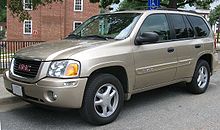
Car manufacturers were keen to promote SUV sales over other types of cars due to higher profits in the segment. An SUV could be sold with a profit margin of US$10,000 or more (US$18,000 per SUV in the case of the Ford Excursion), while compact cars were often sold at a loss of a few hundred dollars per car.[110][111][112] As a result, several manufacturing plants were converted from car production to SUV production (such as the General Motors plant in Arlington, Texas in 1996), and many long-running U.S. sedan models were discontinued.[113][114][115]
From the mid-2000s until 2010, U.S. sales of SUVs and other light trucks experienced a dip due to increasing fuel prices and then a declining economy. From 2008 until 2010, General Motors closed four assembly plants that were producing SUVs and trucks.[116] Sales of SUVs and light trucks sales began to recover in 2010, as fuel prices decreased and the North American economy improved.[117]
2010s to 2020s
[edit]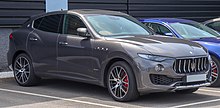
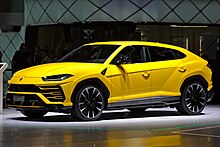
In 2019, the International Energy Agency (IEA) reported that the global number of SUVs and crossovers on the road multiplied by six since 2010—from 35 million to 200 million vehicles, and their market share has grown to 40 percent of worldwide new light-vehicle sales at the end of the decade.[118]
By 2013, small and compact SUVs had increased to become the third-largest market segment.[33] Since the early 2000s, new versions have been introduced to appeal to a wider audience, such as crossovers and other small SUVs.[119] Larger SUVs also remained popular, with sales of General Motors' large SUV models increasing significantly in 2013.[120]
In 2015, global sales of SUVs overtook the "lower medium car" segment, to become the largest market segment, accounting for 22.9% of "light vehicle" sales in 2015.[119] The following year, worldwide SUV sales experienced further growth of 22%. The world's fastest-growing SUV markets in 2014–2015 were: China (+ 47.9%), Italy (+ 48.6%), Spain (+ 42%), Portugal (+ 54.8 %), and Thailand (+ 56.4%).[119] The SUV segment further grew to 26% of the global passenger car market in 2016, then to 36.8% of the market in Q1–Q3 of 2017.[121][122][119]
In the U.S. at the end of 2016, sales of SUVs and light-duty trucks had surpassed traditional car sales for the year by over 3 million units.[123] Manufacturers continued to phase out the production of sedan models, replacing them with new models of SUVs.[124] Luxury brands have increasingly introduced SUV or crossover models in the 2010s. For example: Rolls-Royce Cullinan, Bentley Bentayga, Aston Martin DBX, Maserati Levante, Lamborghini Urus, and Ferrari Purosangue.[125]
In 2019 SUVs made up 47.4% of U.S. sales compared to only 22.1% for sedans.[126]
Motorsport
[edit]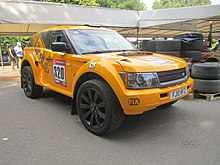
SUVs have competed in various off-road racing competitions, such as the Dakar Rally, Baja 1000, FIA Cross-Country Rally World Cup, King of the Hammers, and Australasian Safari. SUVs have also competed in the Trophee Andros ice-racing series.
Nicknames
[edit]Several derogatory or pejorative terms for SUVs are based on the combination of an affluent suburb name and "tractor", particularly for expensive vehicles from luxury brands. Examples include "Toorak Tractor" (Melbourne, Australia),[127][128] "Chelsea Tractor" (London, England)[129] and "Remuera Tractor" (Auckland, New Zealand). These terms relate to the theory that four-wheel drive capabilities are not required by affluent SUV owners, and that the SUV is purchased as a status symbol rather than for practical reasons.
In Norway, the term Børstraktor ('Stock Exchange Tractor') serves a similar purpose.[130] In the Netherlands, SUVs are sometimes called "P.C. Hooft-tractors" after the exclusive P.C. Hooftstraat Amsterdam shopping street.[131]
Commercial SUVs
[edit]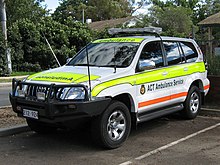
A commercial SUV is an SUV or crossover, that is used for commercial purposes. The category is very similar to panel trucks since the Chevrolet Suburban (an SUV) had panel truck versions, which were used for commercial purposes.
The first SUV-like vehicle that had commercial versions was the Chevrolet Suburban panel truck. Panel trucks by American manufacturers were built until the late 1970s.
While panel trucks manufactured by European manufacturers were rare, commercial versions of off-road vehicles were very common, Land Rover manufactured commercial versions of the Land Rover and the Defender. Commercial SUVs are factory-built and most of them are not independent conversions, which means they can be bought from dealerships and showrooms.[132]
Examples of SUVs used as commercial vehicles in Europe include: Citroen C5 Aircross Commercial SUV,[133] the Land Rover Discovery, the Dacia Duster Flika,[134] and the Mitsubishi Pajero.
See also
[edit]References
[edit]Notes
[edit]- ^ "SUV Meaning: What is an SUV?". Car and Driver. 13 April 2020. Retrieved 30 August 2022.
- ^ a b Wardlaw, Christian (15 September 2021). "What is a Crossover SUV?". J.D. Power. Retrieved 30 August 2022.
- ^ "New registrations of SUVs in key car markets, 2010-2021 – Charts – Data & Statistics". iea.org. 21 December 2021. Retrieved 1 October 2024.
- ^ a b c d e Cozzi, Laura; Petropoulos, Apostolos. "Growing preference for SUVs challenges emissions reductions in passenger car market". International Energy Agency. Archived from the original on 4 February 2020. Retrieved 18 February 2020.
On average, SUVs consume about a quarter more energy than medium-size cars. As a result, the global fuel economy worsened caused in part by the rising SUV demand since the beginning of the decade, even though efficiency improvements in smaller cars saved over 2 million barrels a day, and electric cars displaced less than 100,000 barrels a day. In fact, SUVs were responsible for all of the 3.3 million barrels a day growth in oil demand from passenger cars between 2010 and 2018, while oil use from other types of cars (excluding SUVs) declined slightly.
- ^ a b Kommenda, Niko (25 October 2019). "SUVs second biggest cause of emissions rise, figures reveal". The Guardian. Retrieved 1 October 2024.
- ^ Rose, Joel (14 November 2023). "Taller cars and trucks are more dangerous for pedestrians, according to crash data". npr.org. Retrieved 1 October 2024.
- ^ Tyndall, Justin (March 2024). "The effect of front-end vehicle height on pedestrian death risk". Economics of Transportation. 37. doi:10.1016/j.ecotra.2024.100342. Retrieved 1 October 2024.
- ^ Lawrence, Eric D.; Bomey, Nathan; Tanner, Kristi (1 July 2018). "Death on foot: America's love of SUVs is killing pedestrians". Detroit Free Press. Archived from the original on 14 December 2019. Retrieved 24 December 2019.
- ^ Gladwell, Malcolm (4 January 2004). "Big and Bad". The New Yorker. Archived from the original on 19 February 2016. Retrieved 1 October 2024.
- ^ a b c Bradsher 2002, p. 4.
- ^ Bumbeck, Mike (27 August 2024). "Utility in Style – The 1972 Jeep Wagoneer blends an iconic design with modern driveability". Hemmings Classic Car. Retrieved 1 October 2024.
- ^ Heaps, Russ (25 March 2022). "SUV vs. Crossover: What's the Difference?". autotrader.com. Retrieved 1 October 2024.
- ^ Glucksberg, Sam (2001). Understanding Figurative Language: From Metaphor to Idioms. Oxford University Press. p. 112. ISBN 9780198027126. Retrieved 1 October 2024 – via Google Books.
- ^ a b "Definition of SUV". Merriam-Webster. Archived from the original on 5 January 2018. Retrieved 26 October 2020.
- ^ "Definition of Sport-utility Vehicle". Merriam-Webster. 3 January 2018. Archived from the original on 8 December 2017. Retrieved 26 October 2020.
an automobile similar to a station wagon but built on a light truck frame
- ^ Webster's New World College Dictionary (Fourth ed.). Houghton Mifflin Harcourt.
- ^ "Stereotype of 'Chelsea tractor' reflects reality of urban SUV sales, says report". The Guardian. 7 April 2021. Retrieved 9 January 2023.
- ^ "Top 10 Best family SUVs 2021". Autocar. 20 January 2021. Retrieved 9 May 2021.
- ^ "Search Chambers: four-by-four". Chambers 21st Century Dictionary. Retrieved 25 July 2021.
- ^ "Search Chambers: jeep". Chambers 21st Century Dictionary. Retrieved 25 July 2021.
- ^ "Search Chambers: off-road vehicle". Chambers 21st Century Dictionary. Retrieved 25 July 2021.
- ^ Collins Cobuild Advanced English Dictionary. HarperCollins. Retrieved 10 November 2019.
- ^ "Regulation (EEC) No 4064/89 - Merger Procedure" (PDF). ec.europa.eu. Luxemburg: Office for Official Publications of the European Communities. 17 March 1999. p. 2. Archived (PDF) from the original on 27 March 2009. Retrieved 3 March 2019.
- ^ "Car prices within the European Union / Prix des voitures au sein de l'Union européenne / Autopreise in der europäischen Union" (PDF). ec.europa.eu (in English, French, and German). Brussels: Publications Office of the European Union. 1 January 2011. Archived (PDF) from the original on 6 November 2011. Retrieved 3 March 2019.
- ^ "Impact on the Competitiveness of the European Automotive Industry of Potential FTA with India and ASEAN" (PDF). europa.eu. p. 8. Archived from the original (PDF) on 29 April 2013.
- ^ Davis, Stacy C.; Williams, Susan E.; Boundy, Robert G. (2016). "Transportation Energy Data Book" (PDF) (35th ed.). Oak Ridge National Laboratory. pp. 3–5. Archived (PDF) from the original on 6 January 2018. Retrieved 25 July 2021.
- ^ Fuhs, Allen (2008). Hybrid Vehicles: and the Future of Personal Transportation. CRC Press. p. 263. ISBN 9781420075342. Retrieved 8 April 2019.
- ^ Yacobucci, Brent D. (17 April 2003). "Sport Utility Vehicles, Mini-Vans, and Light Trucks: An Overview of Fuel Economy and Emissions Standards" (PDF). CRS Report for Congress. Archived (PDF) from the original on 16 August 2017. Retrieved 23 December 2011.
- ^ "The Plain English Guide to the CleanAirAct" (PDF). United States Environmental Protection Agency. April 2007. p. 8. Archived (PDF) from the original on 14 October 2015. Retrieved 6 December 2017.
- ^ "Light Duty Vehicle Emissions". 29 June 2022. Retrieved 10 January 2023.
EPA first set greenhouse gas emission standards for vehicles in 2010, which took effect in MY 2012.
- ^ "Fact #726: SUVs: Are They Cars or Trucks?". Office of Energy Efficiency & Renewable Energy (EERE) U.S. Department of Energy. 7 May 2012. Archived from the original on 12 January 2014. Retrieved 12 January 2014.
- ^ Fuhs, Allen (2008). Hybrid Vehicles: and the Future of Personal Transportation. CRC Press. p. 7. ISBN 9781420075342. Retrieved 6 December 2017.
- ^ a b "Production of Small and Compact SUVs Shifts to Top Gear in North America, Finds Frost & Sullivan". prnewswire.com (Press release). 14 January 2014. Retrieved 14 January 2014.
- ^ Bhattacharya, Sindhu (20 December 2013). "Budget 2013: Why SUV found special mention this budget day". Firstpost. Retrieved 6 December 2017.
- ^ "SUV tax creating uneven playing field: Mahindra". NDTV. 2 May 2013. Retrieved 6 December 2017.
- ^ "Tariff reduction will soften price rises". Blog.autopeople.com.au. 18 November 2008. Archived from the original on 6 January 2009. Retrieved 16 November 2010.
- ^ "Matters of great import". Carpoint. 6 January 2010. Retrieved 16 November 2010.
- ^ Lecco, Tommaso (6 February 2024). "Paris to SUVs: Get off my streets!". Politico.
- ^ "M-72 all-terrain vehicle". spb.ru (in Russian). Retrieved 13 April 2019.
- ^ Thompson, Andy (2008). Cars of the Soviet Union. Somerset, U.K.: Haynes Publishing. p. 57.
- ^ "Jeep Grand Cherokee Review". Edmunds. Retrieved 10 April 2011.
- ^ Hunting, Benjamin (21 April 2019). "The 6 Best (and 5 Weirdest) 2 Door SUVs of All Time". DrivingLine. Retrieved 16 January 2021.
- ^ DeMuro, Doug (1 April 2013). "Attention Automakers: Please Stop Selling Two-Door SUVs". The Truth About Cars. Retrieved 16 January 2021.
- ^ DeMuro, Doug (21 June 2017). "Every Single Two-Door SUV Has Failed". Autotrader. Retrieved 16 January 2021.
- ^ "Toyota Sharpens Best-Selling Prado Range" (Press release). Australia: Toyota. 14 October 2013. Archived from the original on 6 March 2016. Retrieved 16 January 2021.
- ^ Hyatt, Kyle; Szymkowski, Sean (15 July 2020). "2021 Ford Bronco pricing: Here's how much the 2-door and 4-door cost". Roadshow. Retrieved 16 January 2021.
- ^ "2020 Jeep Wrangler 2-Door: Lowest Cost to Own Among Off-Road SUVs". Kelley Blue Book. 5 February 2020. Retrieved 16 January 2021.
- ^ Lee, Christian (2007). High-Performance Jeep Wrangler TJ Builder's Guide. CarTech. p. 14. ISBN 9781932494266. Retrieved 16 January 2021.
- ^ a b c d e f g SUV safety: issues relating to the safety and design of sport utility vehicles: hearing before the Committee on Commerce, Science, and Transportation. United States Senate, One Hundred Eighth Congress, first session. 26 February 2003. p. 18. ISBN 9781422334188 – via Diane Publishing.
- ^ Valdes-Dapena, Peter (16 October 2019). "Volvo's first fully electric car will also be one of its safest cars ever". CNN Business. Retrieved 30 August 2022.
- ^ Penenberg, Adam (2003). Tragic Indifference: One Man's Battle with the Auto Industry over the Dangers of SUVs. HarperBusiness. p. 12. ISBN 0-06-009058-8.
- ^ "Jeep Grand Cherokee fails Swedish moose test, lessons for U.S. consumers". Consumer Reports. 13 July 2012. Retrieved 27 August 2020.
- ^ a b Bradsher 2002.
- ^ "The 50 Worst Cars Of All Time". Time. 7 September 2007. Archived from the original on 13 September 2007. Retrieved 23 May 2010.
- ^ Croft, Robin (2006). "Folklore, families and fear: understanding consumption decisions through the oral tradition". Journal of Marketing Management. 22 (9/10): 1053–1076. doi:10.1362/026725706778935574. ISSN 0267-257X. S2CID 144646252.
- ^ "When cars and SUVs crash: Bumper mismatch boosts costs". CNN. 2 December 2010. Retrieved 14 April 2019.
- ^ "Q&As – Vehicle size and weight". U.S.: Insurance Institute for Highway Safety. April 2018. Retrieved 11 February 2019.
- ^ "Side-impact crash test program". Insurance Institute for Highway Safety. Archived from the original on 30 December 2010.
- ^ "Improved vehicle designs bring down death rates".
- ^ Oltermann, Philip (9 September 2019). "Berliners call for 4x4 ban after four people killed in collision". The Guardian. ISSN 0261-3077. Retrieved 12 May 2020.
- ^ "New study suggests today's SUVs are more lethal to pedestrians than cars". US: Insurance Institute for Highway Safety. 16 June 2020. Retrieved 16 January 2021.
- ^ Dean, Tamara (22 November 2022). "'He was fast … he ran you right over': what it's like to get hit by an SUV". The Guardian. Retrieved 10 April 2023.
- ^ Edwards, M.; Leonard, D. (September 2022). "Effects of large vehicles on pedestrian and pedalcyclist injury severity". Journal of Safety Research. 82: 275–282. doi:10.1016/j.jsr.2022.06.005. PMID 36031254. S2CID 249860954.
- ^ "Source The AutoChannel". The Auto Channel. Retrieved 31 December 2010.
- ^ "Kreisel Electric and Arnold Schwarzenegger present the world's first electrified Hummer H1". Austria: Kreisel. Retrieved 24 January 2020.
- ^ Lianos, Miguel (23 June 2004). "Hydrogen cars ready to roll - for a price". U.S.: NBC. Retrieved 24 January 2020.
- ^ Tobert, Andrew (7 September 2019). "Bigger is not better – how SUVs are killing the climate". Greenpeace International. Retrieved 24 January 2020.
- ^ "Smart Buying Essentials What is a Crossover Vehicle?". Intellichoice. Archived from the original on 17 July 2011. Retrieved 27 July 2015.
- ^ Isidore, Chris (9 January 2006). "GM and Ford's New Cross to Bear". CNN Money. Retrieved 27 July 2015.
- ^ "Crossover 101". aol.com. Archived from the original on 16 April 2016.
- ^ "Difference between a crossover vehicle and SUV?". hertzcarsales.co.uk. 30 January 2019. Archived from the original on 6 November 2020. Retrieved 22 April 2019.
- ^ "What is the Difference Between Crossovers and SUVs? « Harbin Automotive". harbinautomotive.com. Retrieved 22 April 2019.
- ^ "What's the Difference Between an SUV, a Crossover, & a CUV?". thenewswheel.com. 30 March 2017. Retrieved 22 April 2019.
- ^ "SUV vs. Crossover: What's the Difference?". autotrader.com. Retrieved 22 April 2019.
- ^ "SUVs vs. Crossovers: What's the Difference?". usnews.com. Retrieved 22 April 2019.
- ^ "The Difference Between SUVs and Crossover Cars". carwriteups.co.uk. 9 April 2018. Retrieved 22 April 2019.
- ^ "What's the difference between a crossover, SUV and 4x4?". carbuyer.co.uk. Retrieved 22 April 2019.
- ^ "SUV vs Crossover: What are the Differences and Similarities?". leasefetcher.co.uk. Retrieved 22 April 2019.
- ^ Carlsson, Mårten (26 June 2018). "Opel Terrängsportbil" [Opel Off-Road Car]. Klassiker (in Swedish). Sweden. Retrieved 11 July 2019.
- ^ "10 Strange Military Vehicles of World War II". wonderslist.com. 30 January 2014. Retrieved 10 April 2019.
- ^ Allen, Jim (10 January 2016). "Origins Of The Jeep: Birthing A 75-Year Legend". Four Wheeler Network. Retrieved 11 February 2019.
- ^ Thomson, Harry C.; Mayo, Lida (2003). The Ordnance Department: procurement and supply. United States Army in World War II: The technical services. Washington, D.C.: Office of the Chief of Military History, Dept. of the Army (published 1960). p. 274 – via United States Army Center of Military History.
- ^ "History 101: The Crosley Automobile". Daily KOS. U.S. 26 May 2014. Retrieved 24 February 2018.
- ^ "Details on Crosley CC Models 1946 - 1948". Crosley Automobile Club. U.S. Retrieved 24 February 2018.
- ^ "Crosley 1948". Archived from the original on 23 February 2018 – via Classic Car Catalogue.
- ^ "1960 Willys Four-Wheel-Drive Station Wagon: Your (Great-) Grandfather's SUV". Autoweek. 15 February 2007. Retrieved 5 October 2017.
- ^ Greg. "The Very First Sport Utility Vehicle: The Jeep Station Wagon". Autoroundup. Archived from the original on 5 October 2017. Retrieved 6 December 2017.
- ^ a b Allen, Jim (1 November 2012). "1959 International Harvester B-120 Travelall – Four Wheeler Magazine". Four Wheeler Network. Archived from the original on 7 January 2018. Retrieved 7 January 2018.
- ^ "The 1958 Station Wagons". Changing Times: The Kiplinger Magazine. Vol. 12, no. 2. February 1958. p. 22. Retrieved 9 January 2018.
- ^ "Why We Love Them: International Harvester Scout". Bring a Trailer. 27 May 2018. Retrieved 15 October 2019.
- ^ Lewin, Tony; Borroff, Ryan (2003). How to Design Cars Like a Pro: A Comprehensive Guide to Car Design from the Top Professionals. MotorBooks/MBI Publishing. p. 191. ISBN 9780760316412.
- ^ "1970 Range Rover advertisement". YouTube. 11 February 2018. Archived from the original on 18 May 2019. Retrieved 13 April 2019.
- ^ "Old Range Rover ad". YouTube. 13 June 2009. Archived from the original on 29 October 2021. Retrieved 13 April 2019.
- ^ "Subaru Leone 4WD Wagon was the first SUV". outbacktravelaustralia.com.au. Retrieved 30 August 2022.
- ^ 自動車ガイドブック [Automobile Guide Book 1975~76] (in Japanese), vol. 22, Japan: Japan Automobile Manufacturers Association, 31 October 1975, pp. 279–280, 0602-509072-2228
- ^ "1974 model year Jeep brochure picture – Cherokee page". U.S.: Jeep. 1973. Retrieved 4 January 2018.
- ^ "1974 model year Jeep Cherokee brochure – front". U.S.: Jeep. 1973. Retrieved 4 January 2018.
- ^ "1966 Ford Bronco U-100 4-Wheel Drive models & features brochure". U.S.: Ford. 1965. Archived from the original on 3 January 2018. Retrieved 4 January 2018.
- ^ "The Lada Niva: Russia's Forgotten Off-Road SUV". 25 December 2019.
- ^ Baxter, Eric (13 July 2011). "Who coined the term 'crossover vehicle?'". howstuffworks. Retrieved 9 May 2021.
- ^ Gold, Aaron (9 May 2017). "AMC Eagle: No, Seriously, This Was the First Crossover SUV". Autotrader. Retrieved 9 May 2021.
- ^ Hunting, Benjamin (14 February 2021). "How Bad Was The Lada Niva, The Ultra-Cheap Alternative Russian 4X4?". DrivingLine. Retrieved 30 August 2022.
- ^ Appel, Tom (9 May 2019). "Review Flashback! 1980 AMC Eagle". The Daily Drive by Consumer Guide. Retrieved 9 May 2021.
- ^ Brubaker, Ken (27 December 2018). "Firing Order: That Time I Bought an AMC Eagle". Four Wheeler. Retrieved 30 August 2022.
- ^ a b c Bradsher 2002, p. 40.
- ^ Ludel, Moses (1995). Toyota truck & Land Cruiser owner's bible. Robert Bentley. p. 18. ISBN 978-0-8376-0159-5. Retrieved 24 June 2011.
- ^ "From the Battlefield to the Soccer Field". Traffic Safety Center Online Newsletter. Summer 2005. Archived from the original on 10 March 2012. Retrieved 8 January 2013.
- ^ Bradsher 2002, p. 41.
- ^ "SUV Craze". Consumers Digest. 1996.
- ^ Schoenberger, Robert (6 June 2008). "As buyers shun SUVs, expect to pay more for that small car". Cleveland Business News. Retrieved 16 November 2010.
- ^ "Ford idle, for now". USA Today. 16 October 2008. Retrieved 23 May 2010.
- ^ White, Jerry (27 May 2000). "GM, Ford idle 1,365 workers-auto industry layoffs signal coming downturn in US economy". Wsws.org. Retrieved 16 November 2010.
- ^ Maynard, Micheline (28 October 2006). "End of the Line for Ford Taurus". The New York Times. Retrieved 15 March 2018.
- ^ "Final Ford Taurus interview". ABC News. 26 July 2007. Archived from the original on 29 October 2021.
- ^ Neff, John (19 October 2006). "So long, friend. Ford producing last Taurus next week". Autoblog. Retrieved 26 July 2007.
- ^ Van Praet, Nicolas (4 June 2008). "Caw Girds For War". Financial Post. U.S. Archived from the original on 16 February 2009. Retrieved 11 February 2019.
- ^ Healey, James (30 July 2010). "Surprise: Sales of big SUVs surging faster than small cars". USA Today. Retrieved 23 April 2012.
- ^ Webster, Ben (14 November 2019). "Soaring demand for SUVs exacerbates climate crisis". The Times. U.K. Retrieved 26 October 2020.
- ^ a b c d "SUVs Become the Largest and Fastest-Growing Automotive Segment in 2015". Euromonitor International. 9 August 2016. Archived from the original on 6 August 2017. Retrieved 26 October 2020.
- ^ Wayland, Michael (20 January 2019). "2015 GMC Yukon and Chevy Suburban, Tahoe: GM expects new SUVs to continue industry dominance". MLive. Michigan, U.S. Retrieved 26 October 2020.
- ^ "World Best Selling SUV 2016". Focus2Move. 25 January 2017. Archived from the original on 29 January 2017. Retrieved 6 January 2018.
- ^ "World Best Selling SUV 2017". Focus2Move. 29 November 2017. Archived from the original on 6 January 2018. Retrieved 6 January 2018.
- ^ "Auto Sales December 2016 compared to 2015". The Wall Street Journal. 4 January 2017. Archived from the original on 5 January 2017. Retrieved 28 October 2020.
- ^ Jeneault, Elizabeth (17 January 2017). "Hyundai Trims Fat, Looks to Add More SUVs to Lineup". suvs.com. Retrieved 28 October 2020.
- ^ Burn, Jonathan (19 March 2018). "Ferrari SUV confirmed fastest SUV crown targeted". Auto Express. Retrieved 10 November 2019.
- ^ Voelk, Tom (21 May 2020). "Rise of S.U.V.s: Leaving Cars in Their Dust, With No Signs of Slowing". The New York Times. Retrieved 14 September 2020.
- ^ "The Australian travel slang dictionary". Australian Traveller. Australia. 9 June 2015. Retrieved 18 February 2018.
- ^ "The evolution of the SUV". eMotor. 3 January 2018. Archived from the original on 17 February 2018. Retrieved 18 February 2018.
- ^ Campbell, Denis (26 September 2004). "Terminator guns for the Chelsea Tractor". The Guardian. London. Retrieved 19 July 2009.
- ^ Sæter, Embret (26 November 2009). "Bloddopet børstraktor" (in Norwegian). DN.no. Retrieved 2 January 2012.
- ^ Nizet, Rik (14 January 2014). "Lamborghini lanceert ook PC Hooft-tractor" [Lamborghini also launches a PC Hooft-tractor]. De Ondernemer ('The Entrepreneur') (in Dutch). De Persgroep. Retrieved 17 February 2018.
- ^ Chin, Joshua (27 July 2020). "The Wonderful World Of The Commercial SUV Market". Automacha. Retrieved 25 December 2020.
- ^ "Citroën C5 Aircross Commercial SUV". Ireland: Citroën. Retrieved 25 December 2020.
- ^ Mihalascu, Dan (21 May 2018). "Dacia Duster Fiskal light commercial vehicle debuts in Austria". Drivemag. Romania. Retrieved 25 December 2020.
Bibliography
[edit]- Bradsher, Keith (2002). High and Mighty: SUVs – The World's Most Dangerous Vehicles and How They Got That Way. New York: PublicAffairs. ISBN 1-58648-123-1.
- Chapman, Giles (2005). SUV: The World's Greatest Sport Utility Vehicles. London: Merrell Publishers. ISBN 1858942748.
- Henshaw, Peter (2005). The Ultimate Guide to SUVs and Off-Road Vehicles. Edison, NJ, USA: Chartwell Books. ISBN 0785818200.
- Jacobs, David H. (1998). Sport Utility Vehicles: The Off-Road Revolution. New York: Todtri Book Publishers. ISBN 1577170857.

